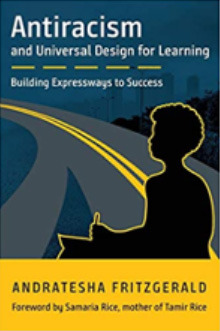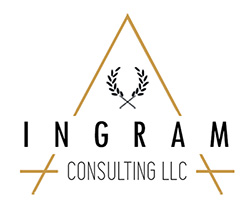 I was honored this past month to visit virtually with East Cleveland (Ohio) City School District’s former Director of Teaching, Learning and Innovation, Andratesha Fritzgerald, a powerful advocate for racial justice in public education. Our conversation centered around her recently published book entitled: Antiracism and Universal Design for Learning – Building Expressways to Success, and we touched on everything from educator authenticity to institutional racism.
I was honored this past month to visit virtually with East Cleveland (Ohio) City School District’s former Director of Teaching, Learning and Innovation, Andratesha Fritzgerald, a powerful advocate for racial justice in public education. Our conversation centered around her recently published book entitled: Antiracism and Universal Design for Learning – Building Expressways to Success, and we touched on everything from educator authenticity to institutional racism.
I’ve known Andratesha since our introduction when her district joined the Ohio Team of the ESSA Leadership Learning Community (ELLC), involving a network of Northeast Ohio school system and community leaders drawn to the work of School Improvement, Leadership, and Equity (a national collaboration project of the Wallace Foundation). The ELLC network has been engaged in leadership for equity work since 2016 as thought partners and bridge builders in support of a public-school model in need of urgent social justice reform and the educators on that mission. I was prepared for a profound and engaging dialogue when we discussed her book, and I think you will find that is exactly what our Q&A session netted.
Q: What was your purpose in writing “Antiracism and Universal Design for Learning – Building Expressways to Success?”
A: The temperature in the world is right for change and I wanted to equip teachers with actions that answer the frequently asked question: “Where do I start?” Antiracism and Universal Design for Learning (UDL) helps teachers of Black and Brown children to understand what it means to honor every child. It also tells them what it means to bring out the best in them, and what strategies you can use to reach them, to teach them, and to learn from them.
Q: How can school districts capitalize on the social justice movement currently sweeping the nation in a way that is sustained as a movement and not just a moment in time? Not only urban schools but suburban and rural ones, as well.
A: A twin pandemic of racism and COVID-19 has cast a spotlight on inequalities that have existed for a long time. Inequities in schools are windows to the larger vision of economic disparity, the digital divide, and most of all racial tensions that are at a fever pitch in this country. But people are now open to taking action to change things. While there is attention to and opportunity for change, we must make a shift in the experience that Black and Brown learners have in and out of the classroom. We can create learning environments that are culturally responsive, culturally sustaining, flexible, and empowering. This is the time for every learning environment to evaluate the experiences and outcomes for all students (and especially Black and Brown learners) and get serious about the work of designing instructional supports for success. Every child deserves an education that is free from the disease of racism and we have an opportunity to make changes on purpose. Now is the time!
Q: Should and how could an anti-racist element be added to teacher training and licensure requirements?
A: Antiracism must become a required component to teacher training and licensure requirements simply because teacher decisions and designs are integral to systems that perpetuate predictable outcomes for learners based on race. We must change teacher preparation if we want to change the data that says Black students are three times more likely to be suspended than their white counterparts. We must change teacher training if we want classrooms designed by teachers with all students in mind. If teachers are not equipped with design strategies and antiracism training, then another generation of Black and Brown students will be marginalized and labeled as failures, when the responsibility for the failure actually belongs to a system that chooses to ignore their needs.
Q: Is there or should there be a differentiation between anti-racism training and anti-black racism training, especially in light of the Black Lives Movement?
A: Antiracist training must address every form of oppression because Black people are not monolithic. Oppression oozes into every cross-section and intersection of our existence. If we are to defeat racism, we must see its multifaceted effects. You cannot separate antiracism from the specificity of anti-blackness if you want to dismantle it. We must confront the antiblackness to tear it down with antiracism.
Q: How can a teaching pool that is largely white teach an anti-racism curriculum with empathy and authenticity?
As I explain in the book, controversy is born the moment dreamers begin taking actions to invite the marginalized ones into the secret society of success. That means, it takes courage to dream beyond the locked gates of educational access for all. When we say “all,” we must identify those students whom the system has not traditionally served. It is more important than ever to recognize that our systems are not just or equitable for our Black and Brown students.
Q: What exactly is Antiracist UDL?
A: It is a merging of methodologies and strategies that acknowledges, identifies, recognizes, names, and studies barriers in systems caused by racism. Once the barriers are acknowledged, identified, recognized, named and studied — then they are systematically dismantled, erased, and eradicated with intentionally designed supports and systems that lead to desired outcomes at every level.
Antiracist UDL is intentional and action oriented. Action and intention are a strategic method to addressing racism. In many systems, racism exists and persists with debilitating outcomes, reminding Black and Brown learners that most systems were not created for them, nor will it change for their success. There are few systems that take on the challenge of being intentionally antiracist, and to be truly antiracist, the system must also be truly universally designed.
Q: We often hear the term “institutional racism,” how does the education system reflect such a structure?
A: Traditional systems that perpetuate institutional racism and block on-ramps to learning are designed for a mythical average learner. One who is white, privileged, at grade-level, and self-regulated. The default language, culture, social and economic assumptions, and goals of traditional public education are oriented toward the white, suburban middle class. Often educators will say, “our systems are broken.” This is not true. Our systems are doing exactly what they were designed to do — allow white privileged students to succeed and move ahead while others are held back. UDL requires us to do better — to name barriers like racism and eliminate them by providing support and high achievement standards for all.
Q: What do you think is your book’s greatest value? What makes it special or worthwhile from your perspective?
This book is for teachers and school leaders who are serious about the actions required for equity to be actualized through antiracist universal design. If we do nothing to change, then we are practicing dishonor to Black and Brown children. We are encouraging their failure and embracing a system that has proven to be racist for as long as schooling has been in existence. Antiracism must be active, not passive. Universal design must be intentionally implemented — not just intended. Success for all must be more than passion. It must be powered by empowerment!
Q: Are you hopeful about a change?
There is hope for change when we decide that we are ready to make changes. The brilliance of Black and Brown children comes alive when we mine for the gem and disturb the status quo.
Andratesha Fitzgerald’s book: Antiracism and Universal Design for Learning – Building Expressways to Success, offers an effective framework for school system leaders and teachers who are committed to promoting leadership for equity and interested in making equitable student learning outcomes actionable.
